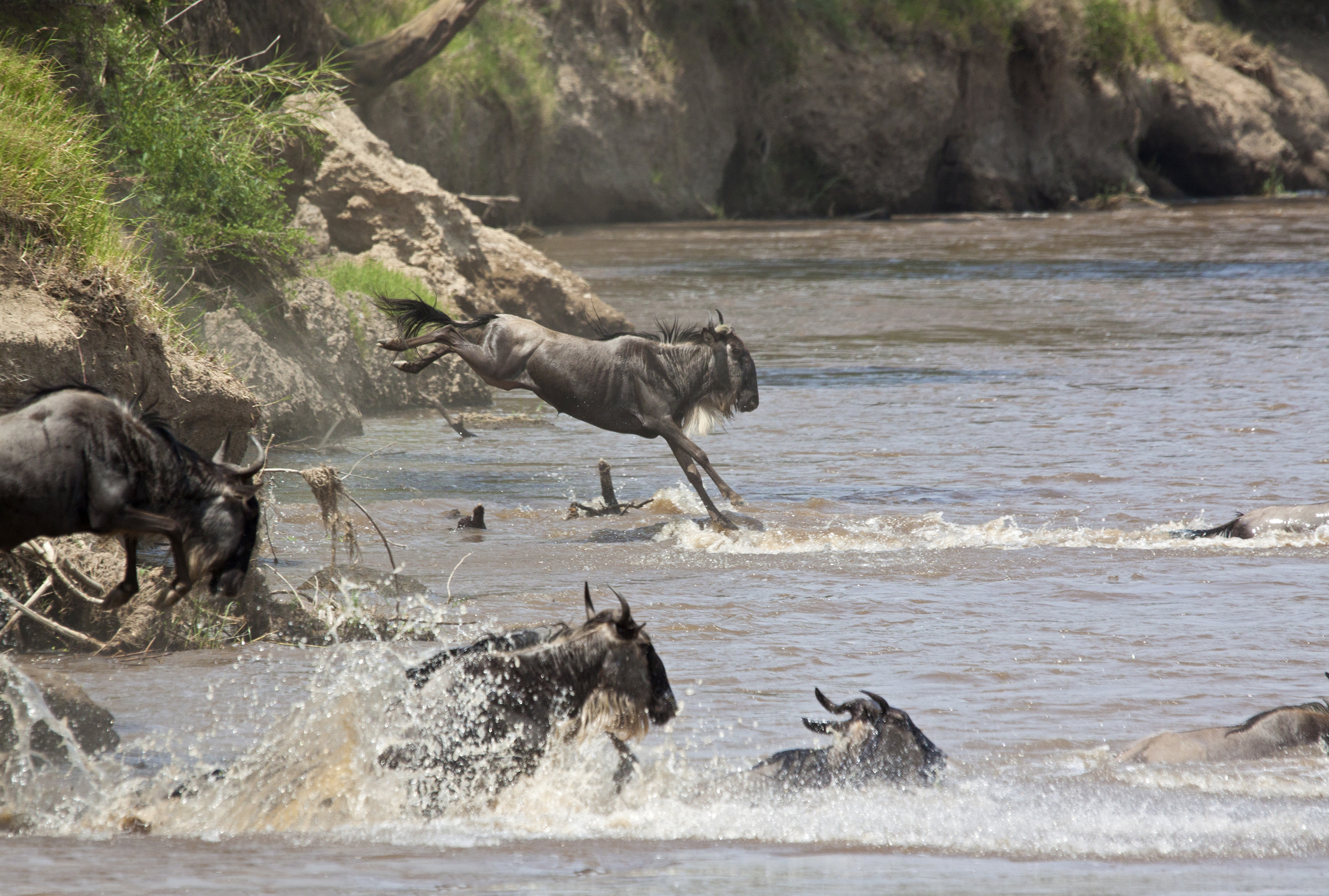“They’re crossing!”
Our safari vehicle lurched forward as Johnathan, our guide, slammed on the accelerator which saw us veer off our path winding parallel to the Mara River and straight towards its banks.
Camera equipment slid across the floor and our knuckles whitened as we drove, hanging on for dear life to prevent a tumble out of the open-sided safari vehicle.

Where there had been a herd of wildebeest grazing nonchalantly at the water’s edge on the other side moments before, there was now frenzied chaos. Panicked, nasal bleating filled the air as a 100-strong herd spilled over the bank in a fast-moving line, forming a black funnel on the embankment.
The adrenalin made our hands shake as we fumbled to hoist camera equipment up and aim, simultaneously in awe at what we were actually seeing and painfully aware of how little time we had to catch this on film.

“There’s a crocodile in the water”
“Where?” I cried.
Sean, my colleague, was watching the scene unfold through his monitor and had seen the telltale ridges of a crocodile slip beneath the surface. The only problem was the river was wide and when we took our eyes off the screen and focused on the scene in front of us, we couldn’t figure out precisely where the camera was pointing. Which meant that we couldn’t figure out where the crocodile was, either.

Frantically scanning the river, I hadn’t realised that one of the first wildebeest had made it to the other side until it emerged at the top of the steep bank directly left of our vehicle. I was startled by a thud as the wildebeest’s front legs gave way from exhaustion and hit the earth. There was a brief moment of silence before it scrambled to a stand and bolted into the safety of the acacia shrubbery behind us.
Wildebeest after wildebeest desperately clambered up the same embankment and I watched, wide-eyed, as they darted past us. And then, after a suspenseful few minutes, it was all over. The waters of the Mara River stilled, all the wildebeest had made it across, and the crocodile was nowhere to be seen, defeated – for today, that is.

As majestic as Mother Nature is, she takes no prisoners, and I couldn’t squash the hopeful feeling that our crocodile friend had gotten trodden on a few times while trying to snap up his late morning meal.
This is the paradox of Africa. You will cheer the wildebeest herd crossing the river and curse the crocodile trailing them as much as you will cheer the cheetah mother hunting a lonely oribi for her three hungry cubs.

The grasslands seem like a graveyard around this time of year, between the months of June and August when the circular, perennial movement of almost two million wildebeest move into the area, joined by several hundred thousand zebra and gazelle.
Carcasses and skeletons are scattered across the landscape, a sure sign of the circle of life at work. I couldn’t help but feel a little rueful as I watched wildebeest walking on the bones of those who came before them, those who had not conquered the Great Migration.

I began to study the bones I spotted, and after enough time in the Serengeti and guidance from our ranger, I began to read them, too. Each told a story. Some seemed almost intact – this could mean the animal who once fed power into those bones had died more recently. Some were spread across a vast area – telltale signs of a hyena at work. And, in some cases, only the skull remained – suggesting that the head that had cased it had breathed its last breathe many years ago.

Even in death, the horns of wildebeest are impressive, in their intricacy and curvature. If the timing is right, you may even spot the keratin moth lurking on the surface of the skull, as it strips away the nutrients and lays its larvae in the crevices of the horn.
The sun was casting a last spotlight of farewell across the savannah as our 4X4 bumped us along back to our camp, Serengeti Under Canvas, and I felt exhausted. One Mara River crossing will do that to you and we were privileged enough to see three in the course of our time travelling around the northern fringes of the Serengeti National Park in Tanzania and the Mara Conservancies in Kenya.

Back at camp, the grass grows to shoulder height painting our surrounds a golden hue. Disguised by the savannah, the wildlife may not be seen but they are most certainly heard with a bleating surround sound hinting at the wildebeest grazing just metres away. When dusk falls, we got used to the drawn-out bark of hyena at night, the lullaby of the Serengeti.
Haven’t read Part 1? You can read it here.
What about Part 3? It’s over here.
Want to know more about the Great Wildebeest Migration? Find out here.


I was totally engrossed from beginning to end. Such exciting writing Melanie.
So glad to hear you enjoyed it, Adele!
These are amazing pictures. I have done South Africa and Kruger in September this year and well i have no words to describe the wildlife experience there. Serengeti, the migration is a dream trip for me and I cannot wait to make it one day soon.
Hi Sonal! I’m as in awe of Africa and it’s beauty as you are! The Great Migration was a dream trip for me, too. Definitely keep it on your To-Do list!